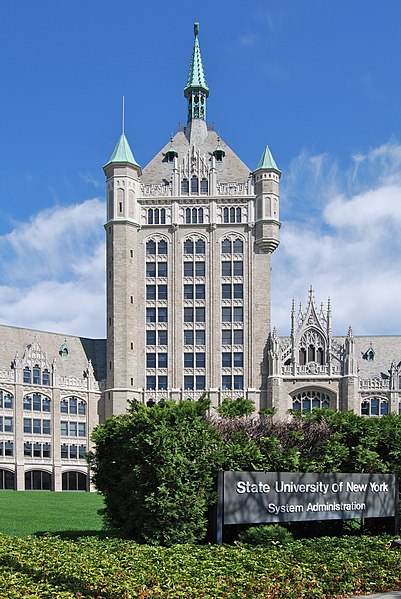The State University of New York, abbreviated SUNY, is a system of public institutions of higher education in New York,United States. It is the largest comprehensive system of universities, colleges, and community colleges in the United States, with a total enrollment of 465,000 students, plus 1.1 million adult education students spanning 64 campuses across the state. The SUNY system has 88,000 faculty members and some 7,660 degree and certificate programs overall and a $10.7 billion budget. SUNY includes many institutions and four University Centers: Albany (1844), Binghamton (1946), Buffalo (1846), and Stony Brook (1957). SUNY's administrative offices are in Albany, the state's capital.
The State University of New York was established in 1948 by Governor Thomas E. Dewey, through legislative implementation of recommendations made by the Temporary Commission on the Need for a State University (1946ր1948). The Commission was chaired by Owen D. Young, who was at the time Chairman of the General Electric Company. The system was greatly expanded during the administration of Governor Nelson A. Rockefeller, who took a personal interest in design and construction of new SUNY facilities across the state.
SUNY comprises all institutions of higher education statewide that are state-supported, with the exception of the institutions that are units of the City University of New York (CUNY), which is additionally funded by New York City.
 he first colleges were established privately, with some arising from local seminaries. But New York state had a long history of supported higher education prior to the creation of the SUNY system. On May 7, 1844, the State legislature voted to establish New York State Normal School in Albany as the first college for teacher education. In 1865 New York created Cornell University as its land grant college, and it began direct financial support of Cornell's statutory colleges in 1894. From 1889 to 1903, Cornell operated the New York State College of Forestry, until the Governor vetoed its annual appropriation. The school was moved to Syracuse University in 1911. It is now the State University of New York College of Environmental Science and Forestry. In 1908, the State legislature began the NY State College of Agriculture at Alfred University.
he first colleges were established privately, with some arising from local seminaries. But New York state had a long history of supported higher education prior to the creation of the SUNY system. On May 7, 1844, the State legislature voted to establish New York State Normal School in Albany as the first college for teacher education. In 1865 New York created Cornell University as its land grant college, and it began direct financial support of Cornell's statutory colleges in 1894. From 1889 to 1903, Cornell operated the New York State College of Forestry, until the Governor vetoed its annual appropriation. The school was moved to Syracuse University in 1911. It is now the State University of New York College of Environmental Science and Forestry. In 1908, the State legislature began the NY State College of Agriculture at Alfred University.Official Site: www.suny.edu/
In 1946-48 a Temporary Commission on the Need for a State University, chaired by Owen D. Young, Chairman of the General Electric Company, studied New York's existing higher education institutions and recommended consolidating them into a state university system. The State University of New York was established in 1948 by Governor Thomas E. Dewey, through legislative implementation of the commission's recommendations. The system was greatly expanded during the administration of Governor Nelson A. Rockefeller, who took a personal interest in the design and construction of new SUNY facilities across the state.
On October 8, 1953, SUNY took a historic step of banning national fraternities and sororities that discriminated based on race or religion from its 33 campuses. Various fraternities challenged this rule in court. As a result, national organizations felt pressured to open their membership to students of all races and religions.
No comments:
Post a Comment